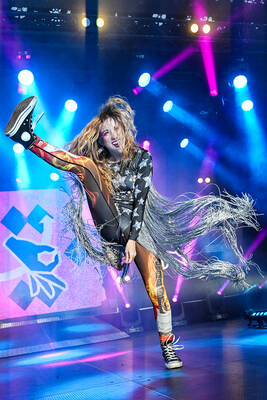Having high levels of caffeine in your blood may lower the amount of body fat you carry and reduce the risk of type 2 diabetes, research suggests.
The findings could lead to calorie-free caffeinated drinks being used to reduce obesity and type 2 diabetes, though further research is required, the researchers wrote in the BMJ Medicine journal.
Katarina Kos, a senior lecturer in diabetes and obesity at the University of Exeter, said the research showed potential health benefits for people with high levels of caffeine their blood, but added: “It does not study or recommend drinking more coffee, which was not the purpose of this research.”

Photo: AP
She said any caffeinated drinks containing sugar and fat would offset the positive effects.
The researchers said their work built on previously published research, which suggested that drinking three to five daily cups of coffee, containing an average 70-150mg of caffeine, was associated with a lower risk of type 2 diabetes and cardiovascular disease.
As those were observational studies, they made it difficult to pinpoint whether the effects were because of caffeine or other compounds, the researchers said.

Photo: Reuters
This latest study used a technique known as Mendelian randomization, which establishes cause and effect through genetic evidence. The team found two common gene variants associated with the speed of caffeine metabolism, and used these to work out genetically predicted blood caffeine levels and whether this was associated with lower BMI and body fat.
People who carry genetic variants associated with slower caffeine metabolism drink less coffee on average, yet have higher levels of caffeine in their blood than people who metabolize it quickly.
The researchers found that nearly half of the reduction in type 2 diabetes risk was driven by weight loss. Caffeine is known to boost metabolism, increase fat burning and reduce appetite, with a daily intake of 100mg estimated to increase energy expenditure by about 100 calories a day.
There are limitations to the findings, including that the research was based on nearly 10,000 people of predominantly European ancestry, who were taking part in six long-term studies.
Stephen Lawrence, an associate clinical professor at the University of Warwick’s medical school, said the study was “interesting” and used “good science,” but noted that the Mendelian assessment was a “relatively new technique” and, although useful, was “vulnerable to bias.”
He said it could lead to future studies that could eventually develop promising treatments.
“This represents good hypothesis-forming or idea-forming science. It does not, however, prove cause and effect. We therefore need to be cautious not to rush to over-interpret it.”
The authors made a “big leap of faith” in assuming that the weight loss brought about by increased caffeine consumption would reduce the risk of developing type 2 diabetes, Lawrence said, adding that it was not more effective than reducing calorie intake and increasing physical activity.
Additionally, caffeine consumption gave some people palpitations and abnormal heart rhythms, so it was not suitable for everyone.
“Should people drink more coffee to reduce fat or diabetes risk? The science suggests relatively good evidence that consuming caffeine increases fat burning, even at rest,” he said. “However, it does not constitute a treatment for obesity and, used wrongly, may result in weight gain or even harm.”

The Taipei Times last week reported that the rising share of seniors in the population is reshaping the nation’s housing markets. According to data from the Ministry of the Interior, about 850,000 residences were occupied by elderly people in the first quarter, including 655,000 that housed only one resident. H&B Realty chief researcher Jessica Hsu (徐佳馨), quoted in the article, said that there is rising demand for elderly-friendly housing, including units with elevators, barrier-free layouts and proximity to healthcare services. Hsu and others cited in the article highlighted the changing family residential dynamics, as children no longer live with parents,

Oct 20 to Oct 26 After a day of fighting, the Japanese Army’s Second Division was resting when a curious delegation of two Scotsmen and 19 Taiwanese approached their camp. It was Oct. 20, 1895, and the troops had reached Taiye Village (太爺庄) in today’s Hunei District (湖內), Kaohsiung, just 10km away from their final target of Tainan. Led by Presbyterian missionaries Thomas Barclay and Duncan Ferguson, the group informed the Japanese that resistance leader Liu Yung-fu (劉永福) had fled to China the previous night, leaving his Black Flag Army fighters behind and the city in chaos. On behalf of the

I was 10 when I read an article in the local paper about the Air Guitar World Championships, which take place every year in my home town of Oulu, Finland. My parents had helped out at the very first contest back in 1996 — my mum gave out fliers, my dad sorted the music. Since then, national championships have been held all across the world, with the winners assembling in Oulu every summer. At the time, I asked my parents if I could compete. At first they were hesitant; the event was in a bar, and there would be a lot

Smart speakers are a great parenting crutch, whether it be for setting a timer (kids seem to be weirdly obedient to them) or asking Alexa for homework help when the kids put you on the spot. But reader Katie Matthews has hacked the parenting matrix. “I used to have to nag repeatedly to get the kids out of the house,” she says. “Now our Google speaker announces a five-minute warning before we need to leave. They know they have to do their last bits of faffing when they hear that warning. Then the speaker announces, ‘Shoes on, let’s go!’ when